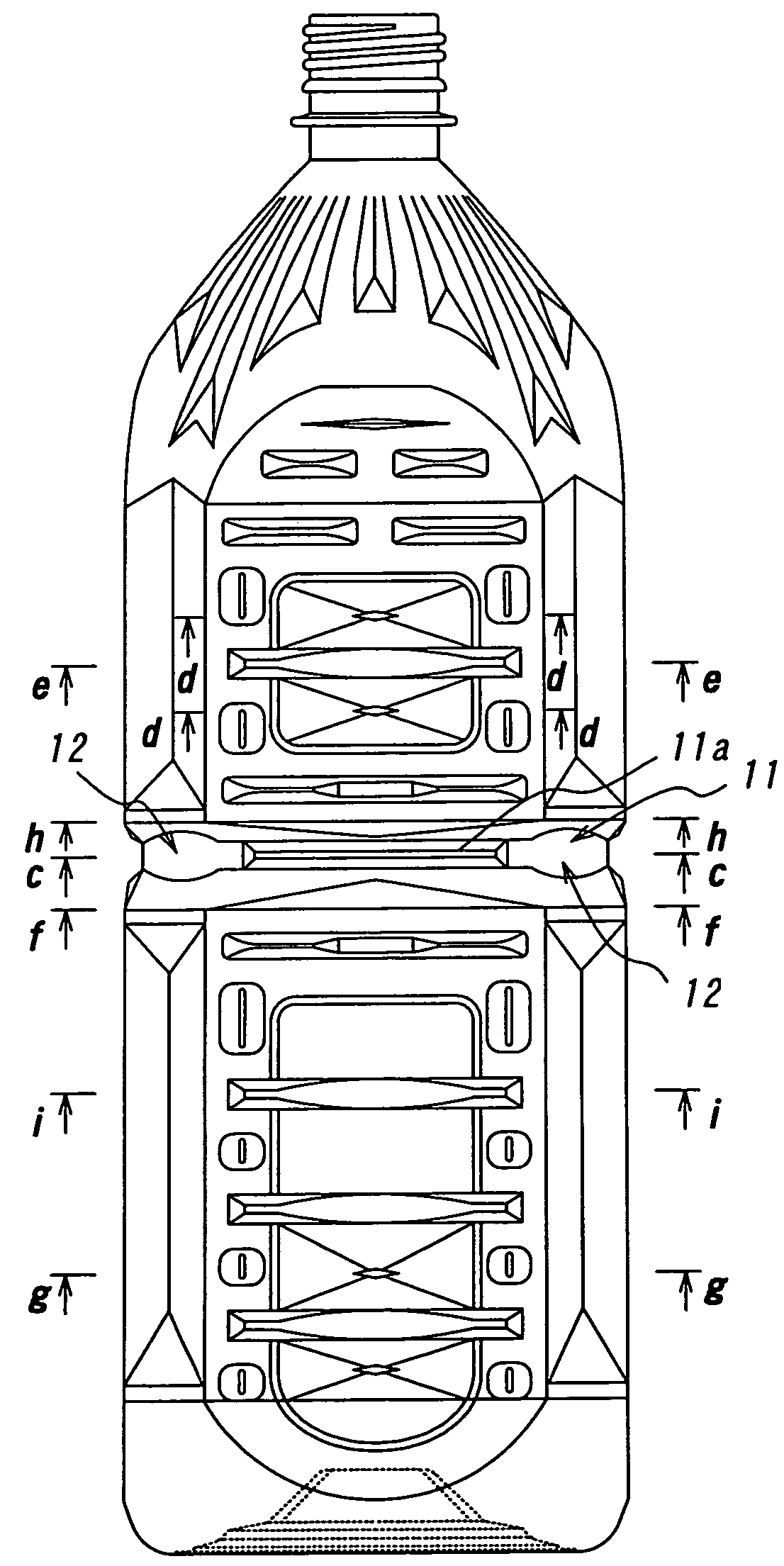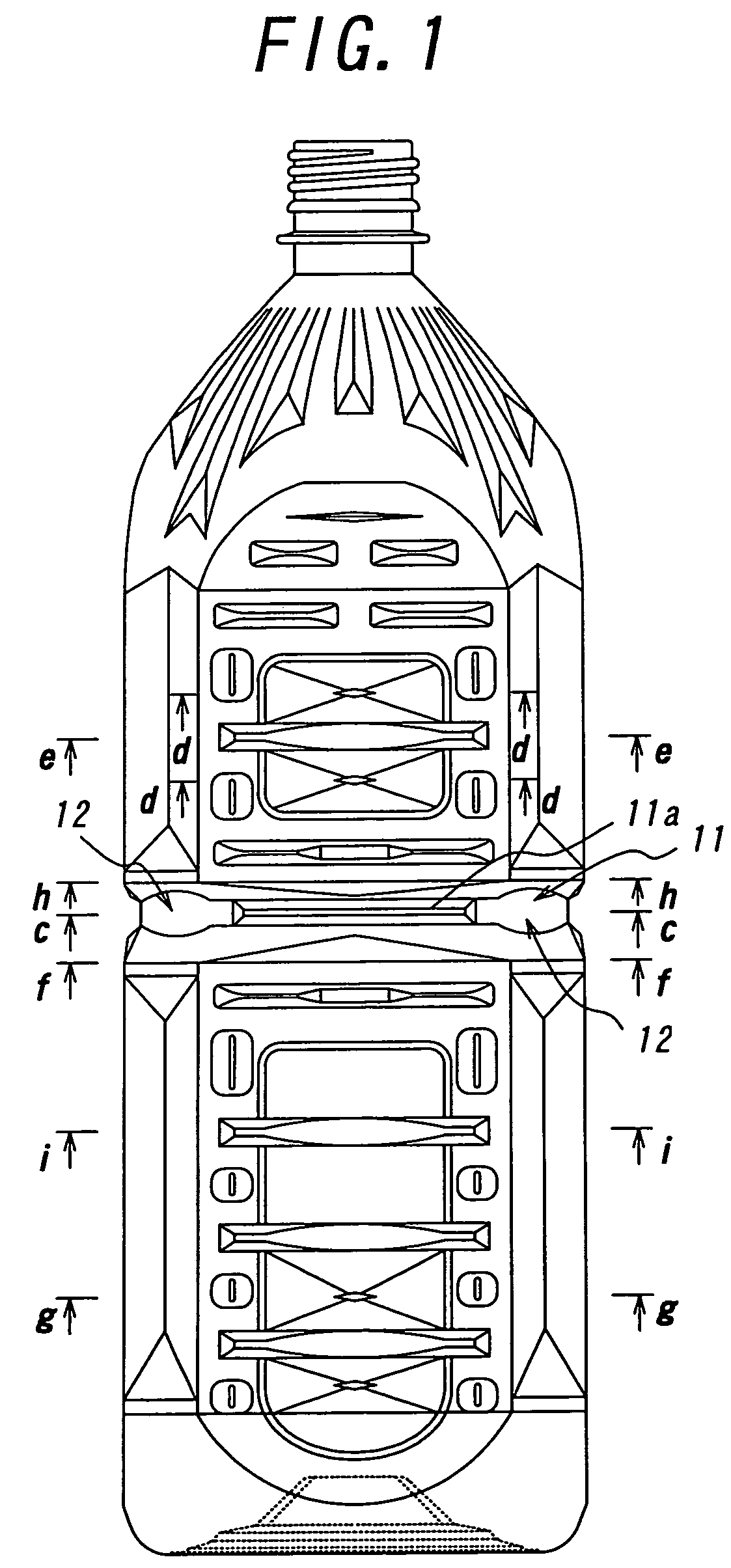Synthetic resin container having improved shape stability
a synthetic resin and container technology, applied in the direction of rigid containers, large containers, packaging, etc., can solve the problems of inevitably reducing the rigidity of the container to cope with such a demand, the container's type of synthetic resin container has a relatively low mechanical strength against external forces, and the container's gripping portion is inevitably deformed, so as to achieve the required shape stability and avoid the effect of lowering the rigidity of the container
- Summary
- Abstract
- Description
- Claims
- Application Information
AI Technical Summary
Benefits of technology
Problems solved by technology
Method used
Image
Examples
first embodiment
[0036]FIG. 1 through FIG. 4 show a synthetic resin container according to the present invention. This container has a filling volume of 2.0 liters and is formed in a substantially quadrilateral cross-sectional shape. Reference numeral 11 denotes a waist which divides a main body portion of the container into upper and lower parts. This waist 11 comprises an annular groove 11a surrounding the main body portion in a manner to become convex toward the interior of the container.
[0037]Reference numerals 12 denotes reinforcing ribs, respectively, each having has a level higher than a groove bottom of the annular groove 11a and lower than the surface of the main body portion. Each reinforcing rib is formed into an arcuate shape at its outer periphery. These reinforcing ribs 12 are provided at four corners of the main body portion of the container in the present embodiment, respectively.
[0038]Although the waist formed by simply recessing the container main body portion and thereby dividing ...
second embodiment
[0045]FIG. 5 and FIG. 6 show a synthetic resin container according to the present invention. Reference numeral 21 denotes a container body, and reference numeral 22 denotes a mouth portion integral with the container body 21. Furthermore, reference numeral 23 denotes a groove portion for dividing the container body 21 into upper and lower parts to thereby enhance the rigidity of the container, and reference numerals 24 denotes pressure-reduction absorbing panels, respectively. Each pressure-reduction absorbing panel 24 has a function for preventing a shape deformation of the container due to a volume change thereof as a result of cooling of the contents therein.
[0046]Reference numeral 25 denotes reinforcing lateral ribs formed at the main body portion of the container so as to extend across the pressure-reduction absorbing panels 24, respectively. Each lateral rib 25 has a concave portion 25a at a central region (i.e., the central region in the longitudinal direction) of the lateral...
third embodiment
[0051]FIG. 7 shows a synthetic resin container according to the present invention. In this embodiment, the region around each longitudinal rib 26 is formed as a concave portion 28 which is lower than surface of the container main body portion such that the contour shape of the longitudinal rib 26 is embossed upon molding the container to thereby further enhance the reinforcing effect near the corner portion of the container, while each lateral rib 25 is made to have a reduced length such that the opposite ends thereof are short of the associated pillars 27, respectively. Such a constitution ensures that the buckling strength is further enhanced in the container having a quadrilateral cross-section, and the restoring ability of the container after deformation is further improved.
[0052]When containers are produced by adopting a polyethylene terephthalate resin as the resin for the container and conducting two times of biaxial-stretching blow molding before and after an intermediate of...
PUM
 Login to View More
Login to View More Abstract
Description
Claims
Application Information
 Login to View More
Login to View More - R&D
- Intellectual Property
- Life Sciences
- Materials
- Tech Scout
- Unparalleled Data Quality
- Higher Quality Content
- 60% Fewer Hallucinations
Browse by: Latest US Patents, China's latest patents, Technical Efficacy Thesaurus, Application Domain, Technology Topic, Popular Technical Reports.
© 2025 PatSnap. All rights reserved.Legal|Privacy policy|Modern Slavery Act Transparency Statement|Sitemap|About US| Contact US: help@patsnap.com



